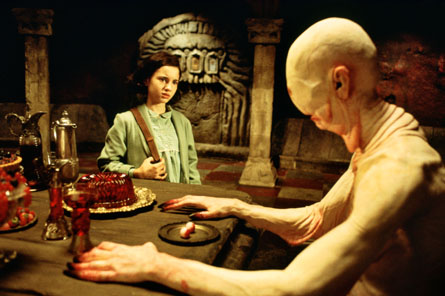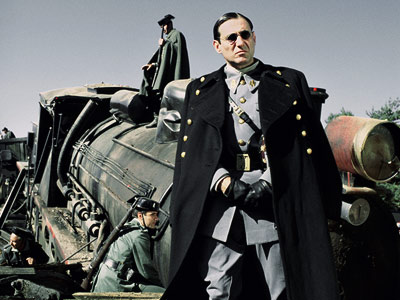Children of Men ***
Directed by Alfonso Cuaron
Written by Cuaron, Timothy J. Sexton, David Arata, Mark Fergus, and Hawk Ostby with Clive Owen, Julianne Moore, Claire-Hope Ashitey, Michael Caine, Pam Ferris, and Chiwetel Ejiofor
Pan’s Labyrinth ****
Directed and written by Guillermo del Toro
With Sergi Lopez, Maribel Verdu, Ivana Baquero, Ariadna Gil, and Doug Jones
Over the past few years three highly talented and ambitious young Mexican film directors — Alfonso Cuaron, Guillermo del Toro, and Alejandro Gonzalez Inarritu — have made their way into the American mainstream. All three seem to have managed this trick by defining themselves mainly in terms of genre, which isn’t surprising given the industry’s insistence that everything be defined according to pitches and formulas, all in 25 words or less — the consequence of a desire to exhaust existing markets rather than attempt to nurture or create new ones.
Cuaron’s done some children’s fantasy (A Little Princess, Harry Potter and the Prisoner of Azkaban) and literary adaptation (Great Expectations), a sex comedy/road movie/coming-of-age story (Y Tu Mama Tambien), and now an action-adventure/SF/war movie (Children of Men). His most ambitious movies seem to cram together several genres — or at least the suits’ notions of genres. Del Toro and Gonzalez Inarritu have both stuck to a single genre: del Toro to horror, Gonzalez Inarritu to the art movie. I would never say that “art movie” is a genre, but the studios treat it that way. I don’t much care for Gonzalez Inarritu’s Amores Perros, 21 Grams, or Babel, despite his indisputable talent in realizing them. Like Christopher Nolan’s Memento, they suggest that art movies are characterized by misanthropic plots that are little more than puzzles to be solved.
For better or for worse, del Toro and Gonzalez Inarritu seem to have fulfilled their potential working within their chosen genres. I don’t think the same can be said of Cuaron. Genre seems to get in the way of his best impulses, as it does in Children of Men, which steadily devolves as he moves from thoughtfully suggestive dystopian science fiction to relatively thoughtless and childish action-adventure to even more mindless war movie. Loosely adapted from a P.D. James novel, the story is set 20 years from now in the UK, in a battered world where (for unexplained reasons) humans have been infertile for the past 18 years and illegal aliens are trucked off to detention camps. The focus is on the members of an underground resistance group, one of whom has miraculously become pregnant. As she flees with a few others toward freedom through an almost constant barrage of gunfire and explosions, the story turns into a rather banal suspense plot about whether she and her child and therefore humanity will survive.
The screenplay is credited to no less than five people, including Cuaron — creativity by committee. Despite some striking details and a mesmerizing performance by Michael Caine as an aging hippie, the movie develops from one that could be described in 25 words or less to one that could be described in 10 or less. Not surprisingly, most critics, including me (I wrote a Critic’s Choice for the film two weeks ago), are obsessed with how adept Cuaron is at handling long takes and a complicated mise en scene — we’re celebrating the technique and minimizing the banality of the story.
By contrast, del Toro’s adherence to a single genre in Pan’s Labyrinth, for which he wrote the screenplay, makes the film impressively personal and original. As a rule, horror-movie fantasies grow out of some version of humdrum reality, but there’s nothing remotely humdrum about the reality underlying Pan’s Labyrinth. It’s set near a mill and a forest in northern Spain five years after the end of the civil war, in 1944, when the defeated Republicans are still hoping for help from the Allies — help that will never come. It’s a desperate situation, yet much of the story is told from the viewpoint of a little girl named Ofelia (Ivana Baquero), who barely understands what’s happening around her and hardly has any connection to the Republicans, apart from a household servant and a local doctor who are secretly members of the resistance. Ofelia’s widowed mother (Ariadna Gil) has recently married a sadistic captain in the Civil Guard (Sergi Lopez); she’s now pregnant, and he’s preoccupied with having a male heir. He’s insisted she come to this remote area even though it endangers her health.
Ofelia responds to all the surrounding tension by conjuring up a faun named Pan (Doug Jones), while an insect she identifies as a fairy follows her around and eventually becomes one. The faun says Ofelia is a reincarnated princess and promptly assigns her three tasks, contained in a storybook whose pages are blank except when she’s alone. Del Toro’s exquisite, integrated digital effects, like Cuaron’s imagined future landscapes, combine the familiar with the uncanny in ways that leave us uncertain which is which.
Pan’s Labyrinth is a fairy tale for grown-ups throughout, even though it maintains a child’s simple view of good and evil. It shuttles back and forth between fascist Spain and a child’s imagination as if those realms were interchangeable — and even containable within the same shot. Like Pere Portabella’s Cuadecuc-Vampir (1970) and Victor Erice’s The Spirit of the Beehive (1973), this film perceives horror traditionally, as something derived from gothic novels and ultimately the Middle Ages. The horror here, linked to both these traditions, is Franco’s fascism, the villain the fascist captain, who roots out, tortures, and kills Republicans. He’s far more frightening than the Dracula of Cuadecuc-Vampir or the Frankenstein of The Spirit of the Beehive, though Ofelia’s fantasies certainly have their creepy and grisly moments. The horror of the captain ultimately trumps any she can imagine, because he seems more real and more metaphysical — the menace he conveys seems to infect the universe. The only equivalent rendering of a child’s perception of terror that comes to mind is Robert Mitchum’s psychopathic preacher in The Night of the Hunter. This is a metaphysical vision, shot through with poetry, and unlike the visions in Babel and 7 , it doesn’t predetermine anything.




